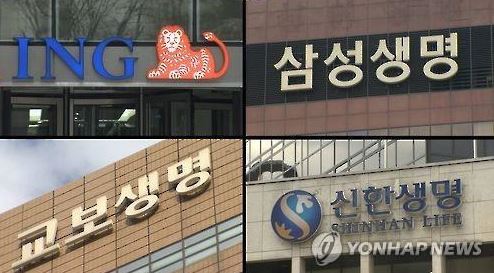The financial health of life insurers in South Korea showed a marked polarization in the first half of the year as foreign players fared far better than local rivals thanks to stepped-up preparations for a new accounting rule, data showed Tuesday.
Four foreign-controlled insurance companies made the list of the top five players with the best financial soundness in the January-June period, with smaller domestic firms languishing at the bottom of the standings.
As of end-June, ING Life Insurance reported the best risk-based capital ratio of 522.6 percent, followed by Samsung Life Insurance with 331.8 percent and LINA Korea with 319.5 percent. AIA Life Korea came next with 260.9 percent, trailed by ABL Life Insurance with 250.8 percent.
RBC refers to the minimum required liquid reserves for a financial institution. The RBC ratio, a key yardstick of financial stability, measures an insurer's ability to absorb losses and pay insurance to policyholders. Local insurers are advised to maintain an RBC ratio of at least 150 percent under industry law.
Four foreign-controlled insurance companies made the list of the top five players with the best financial soundness in the January-June period, with smaller domestic firms languishing at the bottom of the standings.
As of end-June, ING Life Insurance reported the best risk-based capital ratio of 522.6 percent, followed by Samsung Life Insurance with 331.8 percent and LINA Korea with 319.5 percent. AIA Life Korea came next with 260.9 percent, trailed by ABL Life Insurance with 250.8 percent.
RBC refers to the minimum required liquid reserves for a financial institution. The RBC ratio, a key yardstick of financial stability, measures an insurer's ability to absorb losses and pay insurance to policyholders. Local insurers are advised to maintain an RBC ratio of at least 150 percent under industry law.

The first-half list represents a great departure from last year's rankings. At the end of last year, three domestic life insurers were among the top five.
Industry sources attributed foreign companies' solid financial soundness to their increased efforts to prepare for the introduction of the new rule, called IFRS17, on the accounting of insurance products in 2021. Under the rule, insurers' liabilities will be assessed on the basis of market value, instead of book value, at the time of a contract.
It's expected to enable a much "fairer" assessment of insurers' ability to withstand stress and also force them to have more capital bases and reserves to cover potential losses. But it will add to insurers' burden to raise their capital base.
Analysts said domestic insurance companies have also been making efforts to bolster their capital base, but they have proved ineffective with small players reporting low RBC ratios.
In particular, KDB Life Insurance had the lowest RBC ratio of 128.4 percent among the 14 life insurers that unveiled their numbers. As of end-2016, the company's ratio came to 125.7 percent, hovering below the recommended level of 150 percent. (Yonhap)







![[Graphic News] More Koreans say they plan long-distance trips this year](http://res.heraldm.com/phpwas/restmb_idxmake.php?idx=644&simg=/content/image/2024/04/17/20240417050828_0.gif&u=)
![[KH Explains] Hyundai's full hybrid edge to pay off amid slow transition to pure EVs](http://res.heraldm.com/phpwas/restmb_idxmake.php?idx=644&simg=/content/image/2024/04/18/20240418050645_0.jpg&u=20240419100350)






![[From the Scene] Monks, Buddhists hail return of remains of Buddhas](http://res.heraldm.com/phpwas/restmb_idxmake.php?idx=652&simg=/content/image/2024/04/19/20240419050617_0.jpg&u=20240419175937)

![[KH Explains] Hyundai's full hybrid edge to pay off amid slow transition to pure EVs](http://res.heraldm.com/phpwas/restmb_idxmake.php?idx=652&simg=/content/image/2024/04/18/20240418050645_0.jpg&u=20240419100350)

![[Today’s K-pop] Illit drops debut single remix](http://res.heraldm.com/phpwas/restmb_idxmake.php?idx=642&simg=/content/image/2024/04/19/20240419050612_0.jpg&u=)